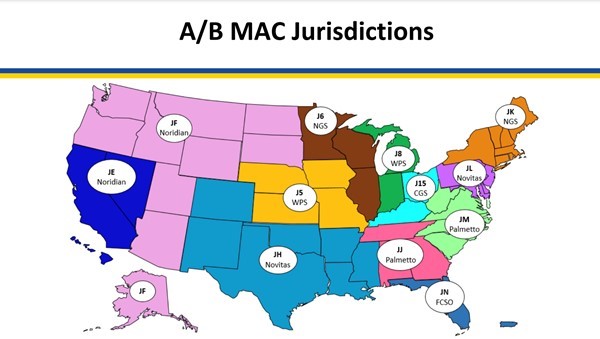Last updated on 11/17/25 | First published on 9/20/18 | Literature review current through Nov. 2025
[cite]
Authors:
Jeff Mize RRT, CHT, UHMSADS,
Tiffany Hamm BSN, RN, CWS, ACHRN, UHMSADS,
more...
Coauthor(s)
Jeff Mize, RRT, CHT, UHMSADS
Disclosures: Nothing to disclose
Tiffany Hamm, BSN, RN, CWS, ACHRN, UHMSADS
Chief Nursing Officer, Wound Reference, IncDisclosures: Nothing to disclose
Editors
INTRODUCTION
To ensure proper Medicare reimbursement and smooth Medicare audits, clinicians must familiarize themselves with the Coding and Reimbursement guidelines for HBOT to ensure compliance with the Centers for Medicare and Medicaid Services. This topic provides a map of the Medicare Part A/B Medicare Administrative Contractors Jurisdictions and respective coverage determinations. For an Introduction to Hyperbaric Oxygen Therapy, see An Introduction to Hyperbaric Oxygen Therapy
NATIONAL OR LOCAL COVERAGE DETERMINATIONS
The map below shows the Medicare Part A/B Medicare Administrative Contractors (MAC) Jurisdictions. MACs determine which types of interventions are covered along with documentation needed to justify medical necessity, utilization guidelines, frequency allowed, etc. Clinicians who bill Medicare should adhere to the guidance provided by their MAC to ensure proper reimbursement and smooth audits should they occur.
Instructions
- Find your state, and respective MAC (in the white bubble)
- On the table below, find your MAC on the left column. The right column indicates if the MAC follows its own Local Coverage Determination (LCD) or if it follows the National Coverage Determination (NCD)
- To go to the NCD or LCD, click on the reference number (in blue brackets in the right column) and go to its reference page. On the reference page, click on the green button "View Source".
- See details on requirements, medical necessity and documentation on specific Medicare National and Local Coverage Determinations

Medicare Administrative Contractors (MAC) as of 3/28/23
Medicare Administrative Contractor (MAC)
| National or Local Coverage Determination (NCD) (LCD)
|
| Novitas Solutions, Inc. |
- NCD 20.29, Effective Date 04/03/2017 [1]
- LCD Hyperbaric Oxygen (HBO) Therapy (L35021)[2] - RETIRED
|
| CGS Administrators, LLC |
- NCD 20.29, Effective Date 04/03/2017 [1]
- Non-Invasive Vascular Studies (L34045), updated on 3/23/2025 [3] - RETIRED
|
| First Coast Service Options, Inc. (FCSO) |
- NCD 20.29, Effective Date 04/03/2017 [1]
- LCD Hyperbaric Oxygen (HBO) Therapy (L36504) [4] - RETIRED
- Noninvasive Physiologic Studies of Upper or Lower Extremity Arteries (L33696) [5] - RETIRED
|
| Noridian |
- NCD 20.29, Effective Date 04/03/2017 [1]
- Billing and Coding: Topical HBO and Physician Related Service Billing and Coding Guidelines (A56025), Revision Effective Date 10/02/2025 [6]
- Billing and Coding: Topical HBO and Physician Related Service Billing and Coding Guidelines (A56026), Revision Effective Date 01/01/2023 [7] - RETIRED
|
| Wisconsin Physicians Service Insurance Corporation (WPS) |
- NCD 20.29, Effective Date 04/03/2017 [1]
|
| National Government Services, Inc. (NGS) |
- NCD 20.29, Effective Date 04/03/2017 [1]
- Non-Invasive Vascular Studies (L33627), Revision Effective Date 10/01/2019 [8]
|
| Palmetto |
- NCD 20.29, Effective Date 04/03/2017 [1]
- Response to Comments: Near-Infrared Spectroscopy in Wound and Flap Management (A59281), Original Effective Date 12/29/2022 [9]
|
Local Coverage Determinations (LCDs) Retirement
Up until 8/27/20, Novitas and FCSO were the only MACs with LCDs. However, based on review of the LCDs and billing and coding article for HBOT, it was determined that they are no longer required and therefore, were retired on 8/27/20. NCD 20.29 is in effect to replace those LCDs, so HBOT coverage is not expected to change in the states covered by Novitas and FCSO.
Of note however, those LCDs previously in place differed from the NCD 20.29 as it relates to HBOT supervision. Also, unlike the NCD 20.29, the retired LCDs laid out specific guidance related to the ability for Advanced Practice Providers (e.g., nurse practitioners) to supervise HBOT services:
- HBOT supervision: the LCDs required "direct" physician supervision, whereas effective January 1 2020, CMS has changed the minimum required level of supervision for hospital outpatient therapeutic services (including HBOT services) furnished by all hospitals and CAHs from direct supervision to general supervision. General supervision means that the procedure is furnished under the physician's overall direction and control, but that the physician's presence is not required during the performance of the procedure. According to CMS, the final decision is ultimately left for each facility to decide at a local level. This change does not preclude a hospital from requiring a higher level of supervision for certain services, as it determines appropriate.[10] See topic "Supervision of HBOT by Providers - Overview"
- Supervision of HBOT by Advanced Practice Providers: unlike the NCD 20.29, the LCDs provided clarification that "Qualified Providers may supervise HBOT services, if such service including definitive evaluation of the patient is included within their State Scope of Practice, or if their required supervision or collaborative agreement is with a physician qualified to provide HBOT services who remains immediately available and if the provider meets the educational requirements identified herein". In practice, the status quo is not expected to change within the states covered by Novitas and FCSO, as the NCD does not provide guidance related to this matter. Supervision of HBOT by advanced practice providers is still subject to the provider's scope of practice within the state of practice, and the ultimate decision lies with each institution, which grants clinical privileges. See topic "Supervision of HBOT by Advanced Practice Providers".
Official reprint from WoundReference® woundreference.com ©2025 Wound Reference, Inc. All Rights Reserved
Use of WoundReference is subject to the
Subscription and License Agreement.
NOTE: This is a controlled document. This document is not a substitute for proper training, experience, and exercising of professional judgment. While every effort has been made to ensure the accuracy of the contents, neither the authors nor the Wound Reference, Inc. give any guarantee as to the accuracy of the information contained in them nor accept any liability, with respect to loss, damage, injury or expense arising from any such errors or omissions in the contents of the work.